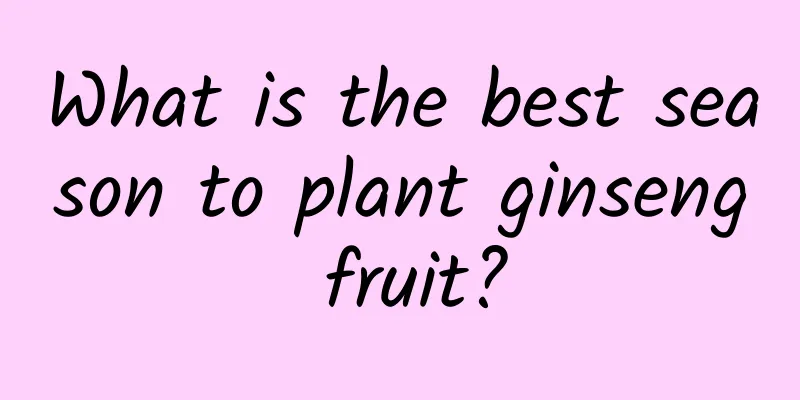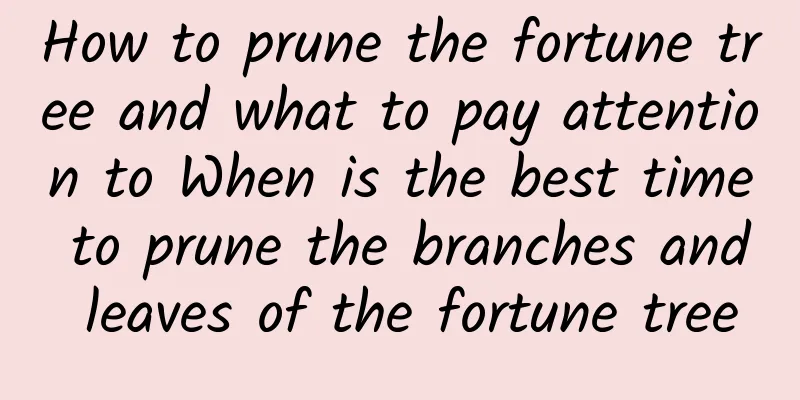What is the best season to plant ginseng fruit?

Ginseng fruit planting season and timeThe season for cultivating ginseng fruit can be spring or autumn. Generally, it is in early February. The ginseng fruit seedlings are cut after new buds grow at the base. After cutting, they are cultivated. They will bloom in about 40 days, which is around mid-March. They can be harvested about 50 days after flowering. Ginseng fruit can also be cultivated on the border of autumn and winter, generally in mid-August. The branches of the fruit trees are cut in mid-August. They will bloom around September 10 and can be harvested on January 1. All ginseng fruits will bear fruit after the Spring Festival. There are two common ginseng fruits in my country. One is a fruit produced in the Andes Mountains of South America, called eggplant, but in China it is called ginseng fruit. It blooms from April to June every year. There is also a plant called ginseng fruit in the Qinghai-Tibet Plateau of China, which is a perennial herbaceous wild plant. Local people call it longevity fruit, Penglai fruit, etc. The fruiting period is around the winter New Year. Ginseng fruit harvest seasonGinseng fruit is usually harvested in winter or autumn. If ginseng fruit can produce about 200 kilograms of one-year seedlings per acre, it will take two years, not longer. Three-year-old seedlings generally bloom next year, so it is best to plant two or more plants. Ginseng fruit planting steps and methods1. Land preparation, fertilization, and planting: Choose neutral soil and loose, fertile, easy to irrigate, ventilated, and light-permeable soil. Ginseng fruit likes fertilizer. Apply fertilizer after planting. Apply 4000-5000 kg of farmyard manure per mu, 50-70 kg of N, P, and K three-element compound fertilizer, 40-70 cm spacing between rows and plants, deep plowing 20-30 cm, level the land, and form a 70 cm wide strip ridge with a height of 10 cm. Select the branches that are more than 10 cm high, and plant them into a shape of 50cm×50cm. It is generally recommended to plant tonight, 2000-3000 plants per mu. After planting, pour in rooting water. 2. Fertilizer and water management: In addition to fertilization, 3 kg of N, P, and K fertilizers are also required per mu, and watering is required except for 10 cm from the main root of the seedling. Boron fertilizer or trace elements such as Su Baofeng No. 2 should be appropriately applied during the flowering and fruiting period. A small amount of nitrogen, phosphorus, and potassium compound fertilizers should be applied frequently, and attention should be paid to inter-cultivation and weeding. Generally, fertilizers are applied once every 10 days, and potassium fertilizers are applied more after flowering. The period when ginseng fruit growth and flowering most require water is from March to June and from September to November, so watering should be done in time. 3. Pruning: Ginseng fruit has strong germination ability, so the branches should be pruned immediately. From the part above 15-20 cm of the plant, select 3-5 strong and evenly distributed branches as the main branches, and remove all the others. Leave 2-3 inflorescences on each side branch, and 2-3 fruits on each inflorescence. Remove all the other inflorescences and small fruits. Each plant can only produce 30 fruits at most. Because the stems of ginseng fruit are very soft, bamboo sticks and plastic ropes must be used to support them when they start to bear fruit to prevent them from falling. |
<<: What are the cultivation methods and precautions of hibiscus?
>>: When is the best season to plant Astragalus membranaceus
Recommend
What to do if potatoes grow too long
What does it look like when potatoes grow leggy? ...
What trees are suitable for planting on the roof? What trees are suitable for planting on the roof?
When planting trees on the rooftop, you should ch...
These 5 kinds of flowers can now be kept alive by just pinching off a branch, and you never have to spend money to buy them again!
Geranium cuttings Geraniums have beautiful flower...
Strawberry planting methods and conditions
Strawberries are rich in vitamins, as well as min...
What to do if the wine bottle orchid has root rot
1. Caused by fertilizer The roots of this plant a...
How to grow green radish so that it grows fast and lush (pay attention to the taboos of growing green radish at home)
First, soil If you want to grow green radish well...
These 15 kinds of flowers, which I played with every day when I was a child, are almost invisible now...
Solanum nigrum Solanum nigrum is not a grape, not...
What is the best month to plant potatoes in Jilin Province?
When is potato planting in Jilin Province Potatoe...
Do succulents need to dry their roots when repotting?
1. Need to dry the roots When repotting succulent...
What is the flower of wealth and prosperity?
1. What is the flower that brings prosperity? The...
How to grow hydroponic daffodils correctly and how long does it take to bloom
1. Correct method of raising 1. Water source sele...
How to prune the branches and leaves of a small fortune tree? How to prune and shape it beautifully
It is best to prune the small money tree in sprin...
The efficacy and function of Trichosanthes
effect Clears heat and relieves cough Trichosanth...
Why do gardenias drop their buds?
1. Excessive watering It is a relatively rare var...
Moonflower blooming season
Moonflower blooming season Moonflowers bloom in s...









